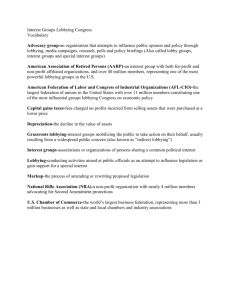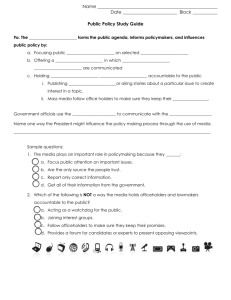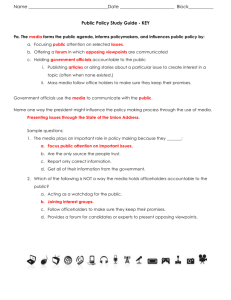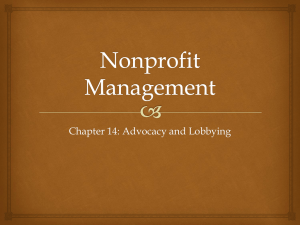Advocacy Reflection paper - Alix Prior's Capstone Portfolio
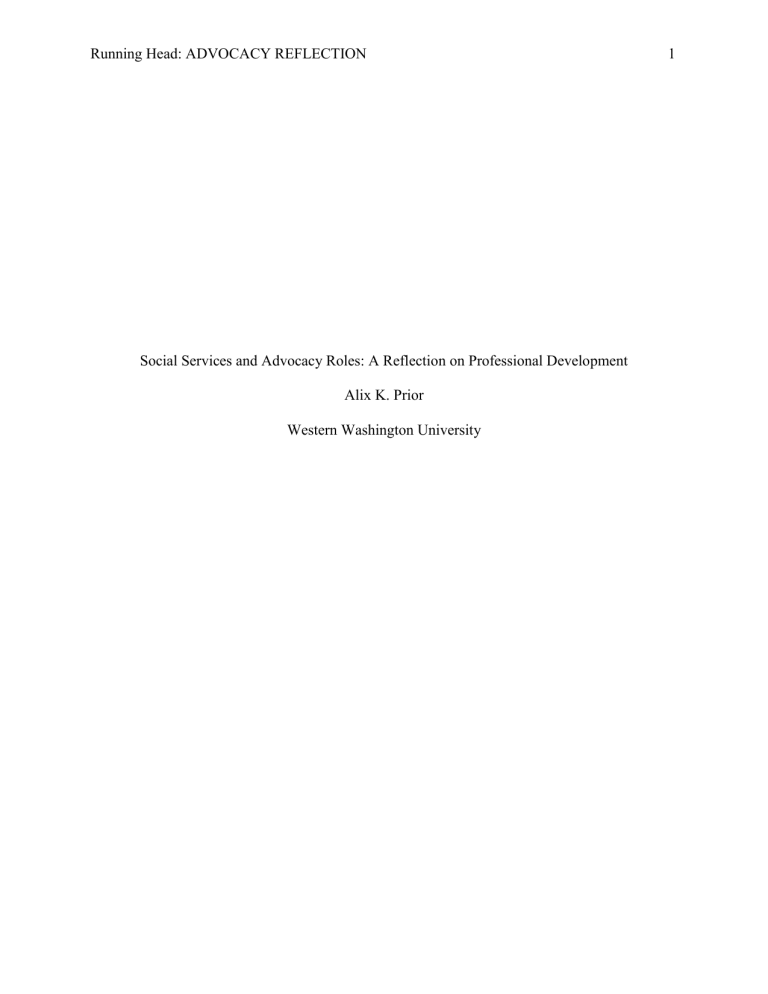
Running Head: ADVOCACY REFLECTION 1
Social Services and Advocacy Roles: A Reflection on Professional Development
Alix K. Prior
Western Washington University
ADVOCACY REFLECTION 2
Within the Human Services field, advocacy plays an integral role in meeting the needs of individuals accessing services. The absence of systemic change efforts maintains power differences and reinforces institutionalized oppression. Therefore, the situations of people that social service providers are intending to serve will not be altered. The varying degrees of marginalization are sustained through socially constructed ideals, norms, and organized processes of operation. Homan (2011) asserts that there has been a shift from community change to largely private practice work within Human Services; however, professionals dedicated to the field must have the willingness to obtain skills in changing conditions because improvements to individuals’ wellbeing cannot occur without doing so. Advocacy techniques include community development and organizing, grassroots movements, and lobbying.
Prior to the senior core sequence, I had not been at all engaged in the political process. I had never considered meeting with my legislators because I was unaware that the option was available and accessible to the general public. There are many tools available via the Internet that allow for individuals to gain knowledge about the local political atmosphere. This includes elected legislators, legislator stances, proposed bills by category, and bill progression ( Bill information , n.d.; Find your legistlaor , n.d; Project vote smart , n.d.). Previously, my impression had been that lobbying activities were tied to advocacy groups, organizations, and individuals very much a part of the political scene. Although I had not felt that my opinion or voice played any significance in the political realm, I had always been interested in participating in the voting process.
Barriers to voting included the inability to vote during the presidential election until this past year and not having ties to my physical residency. My parents currently live in Vancouver,
Washington where I had lived for only one and half years before coming to Bellingham.
ADVOCACY REFLECTION 3
Generally, my family avoids discussion and activity surrounding politics. Once I had reached voting age, I was unaware of the process and was transitioning into college. Until this past year I did not know that, as a student, I had the ability to vote in Whatcom County. Bellingham is a location where I feel strong connections to the community and have created the roots of my professional development; the familiarity to the area and knowing people directly impacted by legislative decisions have encouraged me to pay closer attention to local politics. Over the course of the quarter I have come to understand the importance that political engagement has on community members, as well as the active role I can partake in as a professional in the Human
Services field.
Previously I had regarded politics and nonprofit work as being very different from one another due to perceived differences of ethics and value systems. I was not familiar with the idea of the two being interconnected as a means of providing services to clients. Being active in the political scene allows for professionals to gain recognition and action surrounding various issues that affect the people who are seeking help. It is easy for nonprofit organizations to become focused on providing direct services to clients and disregard advocacy work. When lobbying, it is important for nonprofits to be tactful because policy change can be more beneficial in the long run in comparison to simply asking for funding (D. Finet, personal communication, February 11,
2013). In my experience it seems that nonprofit organizations often spend time seeking out donations and funding for programs, rather than emphasizing shifts in policy to create sustainability. Many agencies do not recognize the power and flexibility there is in being able to participate in lobbying activities.
Class readings and discussions were helpful in outlining the regulations and freedoms of nonprofit lobbying. Tax-exempt nonprofit organizations are classified by the IRS as a 501(3)(c)
ADVOCACY REFLECTION 4 and are often referred to as charitable organizations. Although these organizations are able to lobby, lobbying activities cannot take up a considerable amount of time in relation to other services that are being provided (Homan, 2010). Nonprofit agencies can spend up to 20% of the first $500,000 of exempt purpose expenditures plus a 5 percent incremental decrease for each additional $500,000, totaling a maximum of $1 million on lobbying efforts (Alliance for Justice,
2003). While there is no limitation to the amount of direct lobbying done by the organization, no more than 25% can be spent on grassroots lobbying. Also, only the lobbying involving expenditure funds are considered under lobbying limits. All cost-free activities, such as volunteering, do not count against those limits (Homan, 2010). This allows for a lot of flexibility in nonprofit lobbying efforts.
Unlike other individuals I have not lived in Washington very long and did not receive a tour of Olympia in the fifth grade, therefore Lobby Day was my first contact with the state capitol. The opportunity to lobby and prepare for the trip in Olympia along with other classmates was helpful in understanding the legislative process. Although my group was unable to meet with our Representatives, Morris’ legislative aid was very willing to speak with us and Lytton addressed the entire Human Services group. I found it very surprising how willing
Representative Lytton was to meet with all of the students and provide information about the legislative process. Lytton appeared to be very involved with her constituents and concerned about representing the members in her district as holistically as possible (K. Lytton, personal communication, February 18, 2013). I did not know how easy it was to connect with representatives and that connecting with them is a great way to get involved in the community
(D. Finet, personal communication, February 11, 2013). I appreciated the encouragement that
Lytton provided in meeting with local representatives and the likelihood of that occurring.
ADVOCACY REFLECTION 5
While taking part in lobbying, I learned more about the process of how a bill becomes a law and the barriers it must overcome. With the goal of lobbying for the support of HB 1108, amending the definition of rape to eliminate the spousal exemption, my team spoke to
Representative Morris’ legislative aid. Although busy, the aid was very willing to take the time to talk with us. She had not heard of the bill, but stated that it is extremely likely that Morris would support it and that, as a result of the current political climate, it would be passed in the
House of Representatives. I had not expected to hear that the bill had not been heard of by them and did not realize how many bills are actually proposed. Although understandable, this seemed to be a shame, especially if someone would be in support of a bill if it were known. (M. Sharp, personal communication, February 18, 2013)
Also, when my group was speaking with Representative Morris’ legislative aid, we asked more about how a bill gets passed. Right before we traveled to Olympia HB 1108 had been passed by the Public Safety Committee and we were unsure what that meant. Creating a law is a very long process and many bills will die during that process. After a bill is created it is referred to a standing committee. If the committee recommends the bill for passage it will then be referred to the Rules Committee. Following this committee the bill will be voted on and, if passed, go through the same process with either the House or the Senate. HB 1108 was recommended for passage by the Public Safety committee and will now be referred to Rules.
Due to the political environment, it is likely that the bill will get passed by the House, but will probably die in the Senate (M. Sharp, personal communication, February 18, 2013).
After developing a better understanding of the process of creating laws I am interested in learning more about the role of committees and the voting process within the House of
Representatives and the Senate. I am not completely clear on how individuals become a part of
ADVOCACY REFLECTION 6 these committees and the process of proposing bills, particularly because bills might not move beyond certain committees or get sent back. I am also interested in how individuals come to operate as professional lobbyists.
The knowledge and experience gained during the quarter has increased my confidence in participating in the United States democratic system as an active and engaged citizen. Becoming familiar with the easy accessibility of information that is available to the public and understanding the general willingness of legislators to hear from constituents is encouraging to share my voice. It is also extremely empowering to feel that there are tangible steps that can be taken in creating change, rather than consistently engaging in dialogue with friends and colleagues whose opinions often align with my own. In addition, to fully work alongside individuals to whom I will be providing services to, being informed and in touch with the local and national political atmospheres will be essential in my professional role. The conditions of the individuals that I will work with will not change without actions taken to eliminate forces of oppression and to ensure that the organizations I am affiliated with have access to necessary resources.
ADVOCACY REFLECTION 7
References
Alliance for Justice (2003). Worry-free lobbying for nonprofits . Retrieved from: http:www.afj.org/assets/resources/resources2/Worry-Free-Lobbying-for-Nonprofits.pdf
Bill information.
Retrieved from: http://apps.leg.wa.gov/billinfo/
Find your legislator (n.d.) .
Retrieved from: http://apps.leg.wa.gov/DistrictFinder/Default.aspx
Homan, M.S. (2011). Promoting community change: Making it happen in the real world .
Belmont, CA: Brooks/Cole.
Project vote smart . (n.d.). Retrieved from: http://votesmart.org/
ADVOCACY REFLECTION 8
References:
Find your legislator
(n.d.) .
Retrieved from: http://apps.leg.wa.gov/Dis trictFinder/Default.aspx
Project vote smart
Retrieved from:
. (n.d.). http://votesmart.org/
Date: What I learned:
1-13-13 There are easy access tools/resources in
Washington State that allow me to be knowledgeable about my representatives, those of whom I did not know previously.
1-13-13 There are easy access resources that enable me to develop an understanding of the causes/bills my representatives do and do not support. This assists me in advocacy by knowing what issues are being discussed and addressed. It isn’t as difficult as I had thought to be informed.
1-13-13 Easy access to bill information and sponsors. Bills can be looked up by category to pinpoint your personal interests if unaware of proposed bills.
What I would like to know more about:
Do all states have the same resources?
8
Bill information.
Retrieved from: http://apps.leg.wa.g
ov/billinfo/
Homan, M.S. (2011).
Promoting community change: Making it happen in the real world .
Belmont, CA:
Brooks/Cole. (chapter 15)
Alliance for Justice
(2003). Worry-free lobbying for nonprofits .
Retrieved from: http:www.afj.org/assets/re sources/resources2/Worry-
Free-Lobbying-for-
Nonprofits.pdf
Class Discussion
7
1-18-13 Nonprofits can lobby up to 20% of their revenue. Cost-free (i.e. volunteer) activities do not count toward lobbying efforts.
Difference between direct and grassroots lobbying.
Barriers nonprofits face when lobbying.
Why do most think they are unable to?
9
9 1-18-13 If able, nonprofits can spend up $1 million lobbying. 501(3)(c) can file for 501(h) status for more flexibility in lobbying, this does not apply to Churches and their affiliates.
9
Level of interest
(1-10):
7
Class Discussion
1-22-13 The 20% of a nonprofit’s revenue spent on lobbying excludes federal money (i.e. grants). Nonprofits are often unable to afford a fulltime lobbyist, but corporations/private sector might have 15 fulltime lobbyists. ABC’s of lobbying: accurate, brief, and courteous.
1-29-13 Continuum of influencing public policy visual; different levels/approaches and the role of lobbying. Interconnectedness of direct services, community organizing, and
9
ADVOCACY REFLECTION 9
Class Discussion/Frank
Ordway
Class Discussion/Dave
Finet
Lobby Day in Olympia public policy.
2-5-13 Process of the creation of bills, including passing the bill and the voting process.
Barriers of getting a bill passed and why if often is in session for years. Landscape of
Olympia (political atmosphere). Sense of how creating the state budget and fiscal notes work and interact. Social services often receive $$ from different streams of funding for one position.
2-11-13 There is a difference between advocacy and lobbying, although they are related.
When an organization’s focus is on direct services it can be difficult to break away from that and do advocacy work. Lobbying is an important part of serving clients.
When lobbying it is necessary to be tactful, policy change may be more sustainable and beneficial in the long run in comparison to asking for funding.
2-18-13 Creating a law is a very long process and many bills will die during that process.
After a bill is created it is referred to a standing committee. If the committee recommends the bill for passage it will then be referred to the Rules Committee.
Following this committee the bill will be voted on and, if passed, go through the same process with either the House or the
Senate. HB 1108 was recommended for passage by the Public Safety committee and will now be referred to Rules. Due to the political environment, it is likely that the bill will get passed by the House, but will probably die in the Senate.
During the process of lobbying and visiting
Olympia, it was surprising to see how willing representatives were to meet with constituents. Although I was unable to meet with my representatives one-on-one,
Lytton addressed the entire Human
Services group and Morris’ legislative aid seemed very engaged during the brief meeting.
Lobbying as a profession
How do representatives and senators join a committee?
How often does voting in either house occur during a legislative session?
10
9
10



